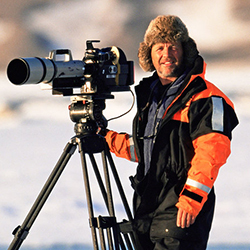Members Login

Channels
Special Offers & Promotions
SLS is delighted to welcome award-winning natural history photographer and film maker Doug Allan to the Scientific Laboratory Show and Conference as one of this year
 Doug Allan: An eye below zero
Doug Allan: An eye below zero
It might surprise you that a film maker would be speaking to an audience of scientists and technicians at a laboratory show. "Where is the overlap between these two disciplines?” you might ask. As it turns out, a lot more than you might think.
We thought we’d let Doug introduce himself and tell us a little bit about his presentation, An eye below zero
I began life as a marine biologist and, in my short career, I did actually publish three papers, including one in Nature. However, I realised that I preferred collecting data and leaving the ‘number crunching’ to other people, so I decided to move into assisting on expeditions. My real breakthrough came with a job as a research diver in the Antarctic, which is also where I developed my interest in photography.
I worked for the British Antarctic Survey for eight years under various guises, at one point as a base commander. In 1981, I met David Attenborough in Antarctica and was lucky enough to help his film crew for a couple of days. I was with the camera operator and I thought to myself: “Wow, everything I enjoy is wrapped up in this job”, so I decided to change direction and become a film maker. Through various ways and means, I got the experience I needed and came up with the idea of making a film about the beauty of the Antarctic. That was my first full-length feature, and my career snowballed from there. Over 5,000 hours underwater and 650 dives under ice later, I’m still amazed I get to do what I do.
When dreaming up a new TV series or trying to find new areas of human behaviour to document, my first port of call is to turn to scientists who are at the forefront of the latest discoveries. Film makers, camera operators and producers owe a huge debt of gratitude to the scientists who carry out the research in the first place – we stand on their shoulders. However, the benefits don’t simply flow one way. There are a number of cases where the film making process itself has actually supported scientific progress. A classic example from my own life is when we were filming killer whales making waves to wash seals off ice floes in the Antarctic. We took a couple of scientists along to help us to find the animals, interpret their behaviour and capture the best camera shots. But joining us also gave them the opportunity to carry out satellite tagging and DNA tests for these particular killer whales, and the results that came out of it were quite ground-breaking. It was a classic symbiosis; they helped us to get the images but, at the same time, we gave them a platform for some innovative research.
This is just one example demonstrating the collaborative relationship between science and film making. I also helped with precise measurements of an iceberg underwater when filming Forces of Nature with Brian Cox, and have always had a keen interest in exploring the impact of climate change throughout my career. Through much of my film making, I not only feel that I am contributing to science, but that science is an integral part of the documentary itself.
See Doug’s full presentation on Wednesday the 23rd of May at the East Midlands Conference Centre at the University of Nottingham. In the meantime, take a look around the website, explore the range of exhibitors attending and look out for seminars and workshops that you want to attend. And you can always keep up with the latest news on Twitter – follow @SciLabShow and #SciLabShow2018.
Media Partners



